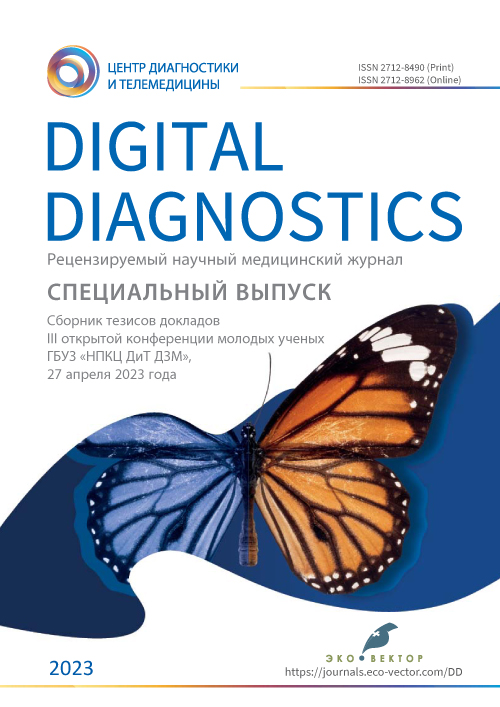Quality control of fat fraction quantification in magnetic resonance imaging: A two-center phantom study
- Авторлар: Panina O.Y.1, Ignatyeva V.A.2, Monakhova A.A.2
-
Мекемелер:
- Research and Practical Clinical Center for Diagnostics and Telemedicine Technologies
- A.I. Yevdokimov Moscow State University of Medicine and Dentistry
- Шығарылым: Том 4, № 1S (2023)
- Беттер: 96-98
- Бөлім: Conference proceedings
- ##submission.dateSubmitted##: 18.05.2023
- ##submission.dateAccepted##: 18.05.2023
- ##submission.datePublished##: 26.06.2023
- URL: https://jdigitaldiagnostics.com/DD/article/view/430357
- DOI: https://doi.org/10.17816/DD430357
- ID: 430357
Дәйексөз келтіру
Толық мәтін
Аннотация
BACKGROUND: Assessment of quantitative parameters using magnetic resonance imaging (MRI) is a relevant trend. Fat fraction (FF) calculation provides new opportunities for accurate diagnosis and will replace invasive methods such as biopsy in the future. Quantification will enable reliable dynamic monitoring and assessment of drug therapy. However, radiologists and clinical specialists must be confident in the accuracy and reliability of the quantitative measures.
AIM: To assess the accuracy of quantitative FF measurement using phantom simulation in the range of 0% to 60%.
METHODS: Emulsions of the “oil-in-water” type were chosen to simulate the objects of the study. Concentrations of vegetable oil-based emulsions were presented in the range of 0% to 60%. Tubes containing the emulsions were placed in a cylindrical phantom. Scans were performed on an Optima, MR450w 1.5 Tesla (GE) tomograph in Lava Flex mode and on an Ingenia, 1.5 Tesla (Philips) tomograph in DIXON mode. FF was determined by formulas using images in In-phase and Out-phase based on signal characteristics (FF=[In–Out]/2∙In∙100) and images weighted by Water and Fat data (FF=Fat/[Fat+water]∙100.
RESULTS: The accuracy of the fat percentage measurement with the DIXON technique was identical to that of the Lava Flex. The data of the measured fat concentration were systematically overestimated in relation to the target values by an average of 57.6% with an average absolute difference of 17.2%. In addition, an irregular underestimation in the range of 20% to 40% was detected.
CONCLUSIONS: Phantom simulation using direct oil-in-water emulsions allowed to control the performance of the Dixon sequences in quantifying the FF. For correct FF quantification, calculation from Water and Fat image data using the formula FF=Fat/(Fat+water)∙100 is preferable. Calculations based on In-phase and Out-phase images provide ambiguous results. The FF calculation in the Lava Flex and DIXON modes must be performed with a correction factor. The use of the phantom allows proper quality control and calibration of the MRI scanner and makes quantitative fat measurement widely available.
Негізгі сөздер
Толық мәтін
BACKGROUND: Assessment of quantitative parameters using magnetic resonance imaging (MRI) is a relevant trend. Fat fraction (FF) calculation provides new opportunities for accurate diagnosis and will replace invasive methods such as biopsy in the future. Quantification will enable reliable dynamic monitoring and assessment of drug therapy. However, radiologists and clinical specialists must be confident in the accuracy and reliability of the quantitative measures.
AIM: To assess the accuracy of quantitative FF measurement using phantom simulation in the range of 0% to 60%.
METHODS: Emulsions of the “oil-in-water” type were chosen to simulate the objects of the study. Concentrations of vegetable oil-based emulsions were presented in the range of 0% to 60%. Tubes containing the emulsions were placed in a cylindrical phantom. Scans were performed on an Optima, MR450w 1.5 Tesla (GE) tomograph in Lava Flex mode and on an Ingenia, 1.5 Tesla (Philips) tomograph in DIXON mode. FF was determined by formulas using images in In-phase and Out-phase based on signal characteristics (FF=[In–Out]/2∙In∙100) and images weighted by Water and Fat data (FF=Fat/[Fat+water]∙100.
RESULTS: The accuracy of the fat percentage measurement with the DIXON technique was identical to that of the Lava Flex. The data of the measured fat concentration were systematically overestimated in relation to the target values by an average of 57.6% with an average absolute difference of 17.2%. In addition, an irregular underestimation in the range of 20% to 40% was detected.
CONCLUSIONS: Phantom simulation using direct oil-in-water emulsions allowed to control the performance of the Dixon sequences in quantifying the FF. For correct FF quantification, calculation from Water and Fat image data using the formula FF=Fat/(Fat+water)∙100 is preferable. Calculations based on In-phase and Out-phase images provide ambiguous results. The FF calculation in the Lava Flex and DIXON modes must be performed with a correction factor. The use of the phantom allows proper quality control and calibration of the MRI scanner and makes quantitative fat measurement widely available.
Авторлар туралы
Olga Panina
Research and Practical Clinical Center for Diagnostics and Telemedicine Technologies
Email: olgayurpanina@gmail.com
ORCID iD: 0000-0002-8684-775X
Ресей, Moscow
Varvara Ignatyeva
A.I. Yevdokimov Moscow State University of Medicine and Dentistry
Email: varvaraigna1612@gmail.com
ORCID iD: 0009-0009-6229-0342
Ресей, Moscow
Alyona Monakhova
A.I. Yevdokimov Moscow State University of Medicine and Dentistry
Хат алмасуға жауапты Автор.
Email: malyona98@gmail.com
ORCID iD: 0009-0009-0271-2953
Ресей, Moscow
Әдебиет тізімі
- Bray TJ, Chouhan MD, Punwani S, et al. Fat fraction mapping using magnetic resonance imaging: insight into pathophysiology. Br J Radiol. 2018;91(1089):20170344. doi: 10.1259/bjr.20170344
- Panina OYu, Gromov AI, Akhmad ES, et al. Accuracy of fat fraction estimation using Dixon: experimental phantom study. Medical Visualization. 2022;26(4):147–158. doi: 10.24835/1607-0763-1160
- Corrias G, Erta M, Sini M, et al. Comparison of Multimaterial Decomposition Fat Fraction with DECT and Proton Density Fat Fraction with IDEAL IQ MRI for Quantification of Liver Steatosis in a Population Exposed to Chemotherapy. Dose Response. 2021;19(2):1559325820984938. doi: 10.1177/1559325820984938
- Reeder SB, Hu HH, Sirlin CB. Proton density fat-fraction: a standardized MR-based biomarker of tissue fat concentration. J Magn Reson Imaging. 2012;36(5):1011–1014. doi: 10.1002/jmri.23741
Қосымша файлдар










